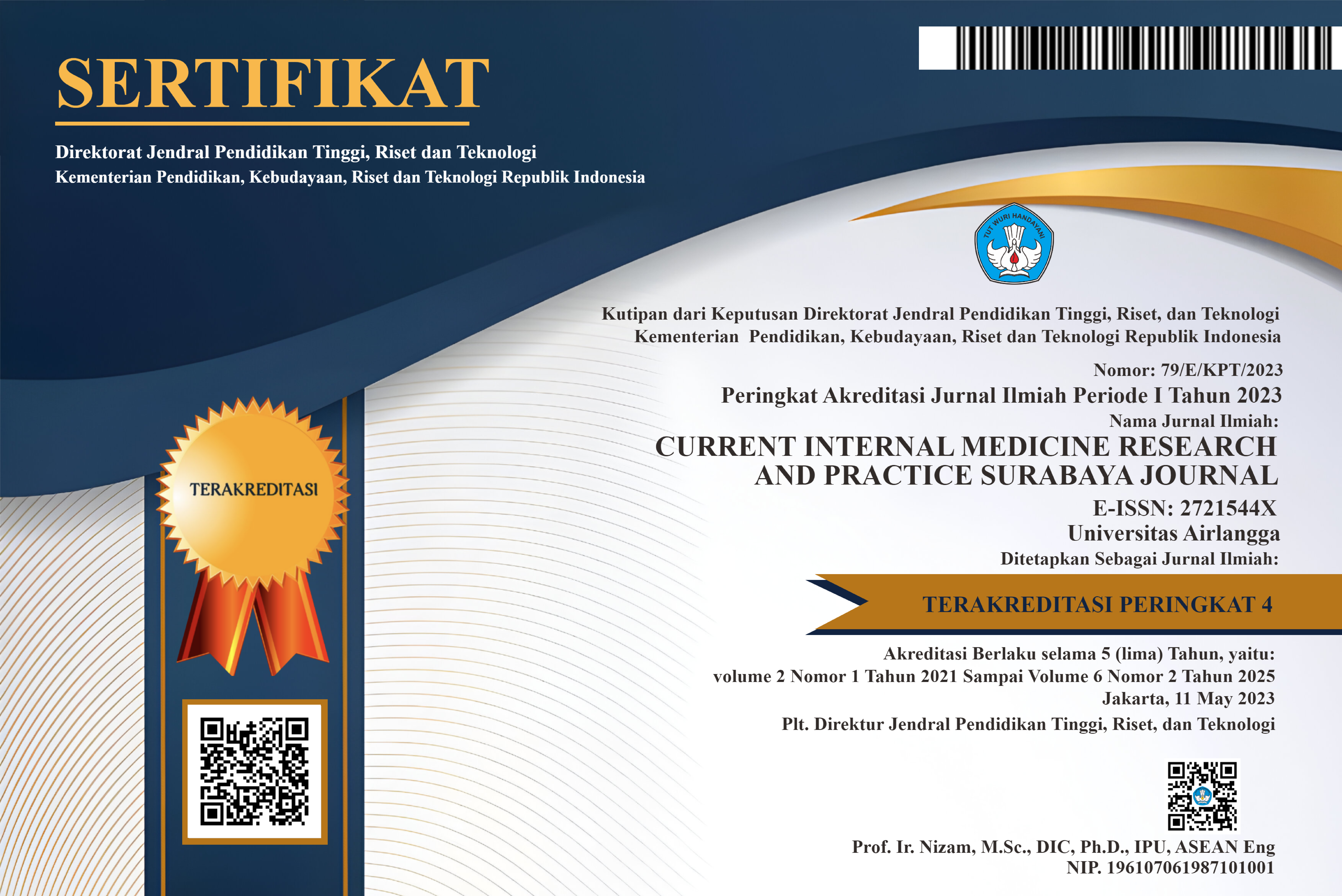Association between Albuminuria and Serum Phosphate Levels in Non-Dialysis Stage 3-5 Chronic Kidney Disease Patients
Downloads
Introduction: Chronic kidney disease (CKD) remains a global burden and catastrophic disease as about 697.5 million people suffering from it in 2017. About 42% of CKD mortality in Indonesia is related to cardiovascular complications. Hyperphosphatemia, a manifestation of chronic kidney disease-mineral bone disorder, could increase the risk of cardiovascular mortality. Albuminuria has been proven to inhibit the compensatory mechanisms for hyperphosphatemia, thereby aggravating this condition. This study was conducted to analyze the association between albuminuria and serum phosphate levels among CKD patients in Dr. Soetomo General Academic Hospital, Surabaya, Indonesia.
Methods: This cross-sectional study used medical records of 129 non-dialysis stage 3-5 CKD patients at the outpatient clinic of Dr. Soetomo General Academic Hospital from March-November 2021. Descriptive analysis was performed on albuminuria, serum phosphate, age, sex, body mass index, comorbid, blood chemistry tests, and CKD stages data. Correlational analysis was conducted using the Spearman Rank test on albuminuria and serum phosphate levels.
Results: The majority of the subjects in this study were male (55.81%); mean age was 55.21±11.99 years; mean BMI was 22.39±2.27 kg/m2; hypertension was found in 65.89% of the patients; mean eGFR was 25.01±16.1 ml/min/1.73 m2 and dominated by CKD stage 3-5. The distribution of albuminuria grade was dominated by heavy albuminuria (>300 mg/g) and the mean serum phosphate level was 4.81±1.9 mg/dl. Spearman Rank analysis found a significant positive correlation with weak association strength (p<0.001; rs=0.277) between albuminuria and serum phosphate levels.
Conclusion: There was a significant positive correlation with weak association strength between albuminuria and serum phosphate levels.
Ansari M, Al-Adeem M, Alshakka M. 2019. Comorbidity among patients with kidney diseases in Hail Region, Saudi Arabia. Int J Diabetes Clin Res 6:104.
Arianti A, Rachmawati A, Marfianti E. 2020. Karakteristik faktor risiko pasien chronic kidney disease (CKD) yang menjalani hemodialisa di RS X Madiun. Biomedika 12:36-43.
Bosman A, Campos-Obando N, Medina-Gomez C, et al. 2022. Serum Phosphate, BMI, and Body Composition of Middle-Aged and Older Adults: A Cross-Sectional Association Analysis and Bidirectional Mendelian Randomization Study. J Nutr 152(1):276-285.
Chang TJ, Zheng CM, Wu MY, et al. 2018. Relationship between body mass index and renal function deterioration among the Taiwanese chronic kidney disease population. Sci Rep 8(1):6908.
Chen H, Li X, Yue R, et al. 2013. The effects of diabetes mellitus and diabetic nephropathy on bone and mineral metabolism in T2DM patients. Diabetes Res Clin Pract 100(2):272-276
Cirillo M, Ciacci C, De Santo NG. 2008. Age, renal tubular phosphate reabsorption, and serum phosphate levels in adults. N Engl J Med 359(8):864-866.
de Seigneux S, Courbebaisse M, Rutkowski JM, et al. 2015. Proteinuria Increases Plasma Phosphate by Altering Its Tubular Handling. J Am Soc Nephrol 26(7):1608-1618.
de Seigneux S, Martin PY. 2016. Phosphate and FGF23 in the renoprotective benefit of RAAS inhibition. Pharmacol Res 106:87-91.
de Seigneux S, Wilhelm-Bals A, Courbebaisse M. 2017. On the relationship between proteinuria and plasma phosphate. Swiss Med Wkly 147:w14509.
Delitsikou V, Jarad G, Rajaram RD, et al. 2020. Klotho regulation by albuminuria is dependent on ATF3 and endoplasmic reticulum stress. FASEB J 34(2):2087-2104.
Fernandez-Fernandez B, Izquierdo MC, Valiño-Rivas L, et al. 2018. Albumin downregulates Klotho in tubular cells. Nephrol Dial Transplant 33(10):1712-1722.
Fernández-Fernández B, Valiño-Rivas L, Sánchez-Niño MD, et al. 2020. Albuminuria Downregulation of the Anti-Aging Factor Klotho: The Missing Link Potentially Explaining the Association of Pathological Albuminuria with Premature Death. Adv Ther 37(Suppl 2):62-72.
GBD Chronic Kidney Disease Collaboration. 2020. Global, regional, and national burden of chronic kidney disease, 1990-2017: a systematic analysis for the Global Burden of Disease Study 2017. Lancet 395(10225):709-733.
Goyal R, Jialal I. Hyperphosphatemia. Treasure Island (FL) [serial online] 2021 Feb [cited 2021 May 17]. Available from: URL: https://www.ncbi.nlm.nih.gov/books/NBK551586/?report=classic
Haider MZ, Aslam A. Proteinuria. Treasure Island (FL) [serial online] 2021 Feb [cited 2021 May 15]. Available from: URL: https://www.ncbi.nlm.nih.gov/books/NBK564390/
Hruska KA, Sugatani T, Agapova O, et al. 2017. The chronic kidney disease - Mineral bone disorder (CKD-MBD): Advances in pathophysiology. Bone 100:80-86.
Jagadeswaran D, Indhumathi E, Hemamalini AJ, et al. 2019. Inflammation and nutritional status assessment by malnutrition inflammation score and its outcome in pre-dialysis chronic kidney disease patients. Clin Nutr 38(1):341-347.
Jung JY, Ro H, Chang JH, et al. 2020. Mediation of the relationship between proteinuria and serum phosphate: Insight from the KNOW-CKD study. PLoS One 15(6):e0235077.
Karim MI. 2019. Karakteristik pasien penyakit ginjal kronis yang dirawat di rumah sakit Hasan Sadikin Bandung tahun 2018. Jurnal Pengabdian Kepada Masyarakat 3: 82-85.
Kementerian Kesehatan RI. 2019. Laporan Nasional Riskesdas 2018. Jakarta: Lembaga Penerbit Balitbangkes. p.169-174.
Khalil R, Kim NR, Jardi F, et al. 2018. Sex steroids and the kidney: role in renal calcium and phosphate handling. Mol Cell Endocrinol 465:61-72.
Kidney Disease: Improving Global Outcomes (KDIGO) CKD Work Group. 2013. KDIGO 2012 clinical practice guideline for the evaluation and management of chronic kidney disease. Kidney Int Suppl 3:19–31, 56-59, 73, 81.
Kim H, Park J, Nam KH, et al. 2020. The effect of interactions between proteinuria, activity of fibroblast growth factor 23 and serum phosphate on renal progression in patients with chronic kidney disease: a result from the KoreaN cohort study for Outcome in patients With Chronic Kidney Disease study. Nephrol Dial Transplant 35(3):438-446.
Koek WNH, Campos-Obando N, van der Eerden BCJ, et al. 2021. Age-dependent sex differences in calcium and phosphate homeostasis. Endocr Connect 10(3):273-282.
Lee WC, Lee YT, Li LC, et al. 2018. The Number of Comorbidities Predicts Renal Outcomes in Patients with Stage 3â»5 Chronic Kidney Disease. J Clin Med 7(12):493.
Li F, Guo H, Zou J, et al. 2018. Urinary excretion of uric acid is negatively associated with albuminuria in patients with chronic kidney disease: a cross-sectional study. BMC Nephrol 19(1):95.
Martín AG, Varsavsky M, Berdonces MC, et al. 2020. Phosphate disorders and clinical management of hypophosphatemia and hyperphosphatemia. Endocrinol Diabetes Nutr 67(3):205-215.
PERNEFRI. 11th Report of Indonesian Renal Registry [serial online] 2018 [cited 2022 Jan 30]. Available from: URL: https://www.indonesianrenalregistry.org/data/IRR%202018.pdf
Schober P, Boer C, Schwarte LA. 2018. Correlation Coefficients: Appropriate Use and Interpretation. Anesth Analg 126(5):1763-1768.
Vikrant S, Parashar A. 2016. Prevalence and severity of disordered mineral metabolism in patients with chronic kidney disease: A study from a tertiary care hospital in India. Indian J Endocrinol Metab 20(4):460-467.
Waziri B, Duarte R, Naicker S. 2019. Chronic Kidney Disease-Mineral and Bone Disorder (CKD-MBD): Current Perspectives. Int J Nephrol Renovasc Dis 12:263-276.
World Health Organization. 2020. The Asia-Pacific perspective: redefining obesity and its treatment. Health Communications Australia Pty Limited. p.17.
Copyright (c) 2023 Ernesto Everald Baibelino Harfonso, Nunuk Mardiana, Atika

This work is licensed under a Creative Commons Attribution-ShareAlike 4.0 International License.
Copyright (c) Author
1. The journal allows the author to hold the copyright of the article without restrictions.
2. The journal allows the author(s) to retain publishing rights without restrictions.
3. The formal legal aspect of journal publication accessibility refers to Creative Commons Atribution-Share Alike 4.0 (CC BY-SA).






















